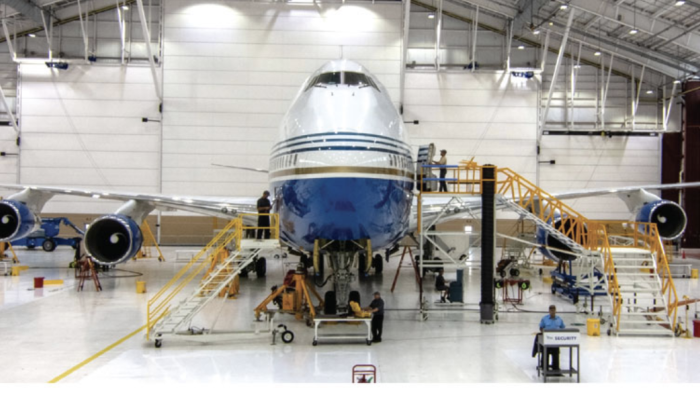Tim Ashenfelter, owner of MSP Jet Center, has a history of finding opportunity in an economic downturn, and last year proved no different. With the aviation industry suffering, GDAS (General Dynamics Aviation Services), the major service provider on Minneapolis International Airport, vacated its maintenance facility, leaving 70 mechanics and 20 administrative people unemployed. Ashenfelter saw an opportunity and made a deal with Signature Flight Support to lease 10,000 sq ft with an option to expand into another 25,000 sq ft.
He hired Dan Henchal, who has a long history in the MRO business, as director of technical services, and opened MSP Jet Center with four employees. The MRO offers maintenance, repair and overhaul on Gulfstream, Astra, Challenger 300 and 600 series, Hawker, Falcon, Citation and Learjet aircraft. It is currently in negotiations to be a designated Honeywell TFE731 service center. It also offers service on the Honeywell HTF7000, Honeywell APU 36 series, Pratt & Whitney Canada PW300 and PW500 series, and Rolls-Royce Tay/Spey.
In addition, MSP Jet Center offers avionics, interior refurb and touch-up paint. Currently MSP Jet Center has a 25,000-sq-ft hangar, 750 sq ft of office space and 850 sq ft of shop space.
“We’re in the process of getting a Part 145 repair station designation and should have it soon,” he said. “Our goal is to increase our technical staff to somewhere between 15 and 20 technicians within the next 24 months.”
Ashenfelter grew up around airplanes. “My father wanted to fly for the Navy but his eyes went bad. Even though he washed out of the aviation program and served his time on a ship, he hadn’t lost his desire to learn to fly. When he got out of the Navy he used the G.I. bill to take flying lessons and got his license in 1948. I was born four years later and some of my earliest memories are of flying,” he told AIN.
Ashenfelter was born in Minneapolis and his father worked for Milwaukee-based Johnson Controls, which kept him traveling. He was a troubleshooter and would go to wherever there was a problem. “When I was six we moved to Los Angeles, then back to Minneapolis when I was eleven. Five years later we moved to the San Francisco bay area.” By his junior year of high school he was “pretty well bitten by the flying bug,” so he took flying lessons and earned his private license by the time he was 17.
After graduation from California Polytechnic State University he took a job as a sales engineer at Johnson Controls. “I was given my choice of staying on the West Coast and working out of Los Angeles or moving back to Minneapolis.” He chose the latter and moved back to the Midwest. “After about two years I was making pretty good money, but I realized it just wasn’t what I wanted to do.”
Ashenfelter said he’d been a “motorhead” most of his life and liked working on cars and motorcycles. “I liked working hands on with machinery, so when an opportunity to work for Cummins Diesel as a sales engineer presented itself, I took it.”
For four years he worked closely with contractors and construction equipment dealers and also sold Cummins marine engines to yacht manufacturers.
“It was right about then that one of my best accounts, Road Machinery and Supplies, offered me a spot as manager of an eleven-man sales team. RMS sold all kinds of construction equipment, including bulldozers, backhoes and cranes. The owner knew I had my private pilot license and occasionally rented an aircraft for business when I worked for Johnson Controls. So he approached me one day about the possibility of using an aircraft in our business. As a result, he helped me purchase a 1973 Baron in return for my using it on company business. It was
an opportunity that opened more doors.”
Ashenfelter said in 1980 he had his airplane based at Modern Aero on Flying Cloud Airport in Minneapolis where they did his maintenance. “I got to know the guys there and when it went in for maintenance I’d ask a lot of questions and would hang around. I also got to know the owner
of the business pretty well.”
Those were bad years economically for general aviation and the maintenance business was dying, so the two devised a plan. They started a separate company for air charter, fuel, sales and flight training to draw in more business for Modern Aero. Ashenfelter said the goal was for him to buy out his partner, who wanted to retire. In 1983, with each partner putting up $5,000 and after securing a line of credit from the bank, they bought a fuel truck and ASI Aero Services was born.
They rented a 600-sq-ft office and empty corporate hangar next door to Modern Aero, leased a 100-octane fuel tank, and Modern Aero did its maintenance. “We were the smallest operation on the airport,” he said.
By 1985 ASI had grown substantially and was particularly successful with the aircraft sales portion of the business, so Ashenfelter bought out his partner, who kept Modern Aero, and the two worked in tandem until 1987, when Ashenfelter bought Modern Aero from him so he could retire.
The company changed its name from ASI Aero Services to ASI Jet Center in 2000 to acknowledge that its focus had expanded to include jet maintenance and sales, Ashenfelter said. “At that point Modern Aero was doing maintenance on pistons, turboprops and light jets, while ASI Jet Center was an area sales rep for the Cessna Caravan. We also sold Piper and Cessna piston aircraft and pre-owned Citations.”
A year later Ashenfelter added Diamond aircraft sales and the business kept growing. In 2005 he built a 35,000-sq-ft storage hangar. “Over the years we’ve acquired eight storage and maintenance hangars and are now the largest FBO/MRO provider on the airport, with a total of 110,000 sq ft of hangar and office space.”







